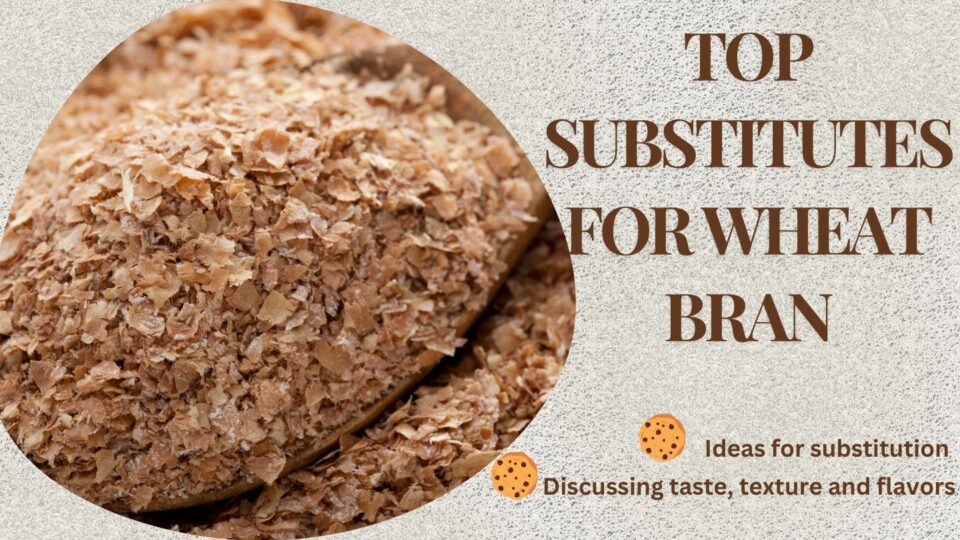Wheat bran is considered healthy on account of being rich in fiber and nutrition. However, there might be times when you want substitutes for wheat bran, owing to several reasons like unavailability or a desire to avoid gluten.
If you want a gluten-free alternative to wheat bran, look at oat bran, rice bran, flaxseed, corn bran, or oatmeal.
Those who’re not concerned about gluten can look at whole wheat flour and farina (cream of wheat) as wheat bran substitutes.
Other alternatives too might be possible depending on the recipe and cooking style. It’s worth remembering that using alternatives can alter the taste or texture of your recipe.
In the section ahead, we’ll take a closer look at the alternatives, the conventional ratios for substitution, and their preferred use in recipes, where applicable.
Table of Contents
Top Wheat Bran Substitutes And Ideas
1. Whole Wheat Flour
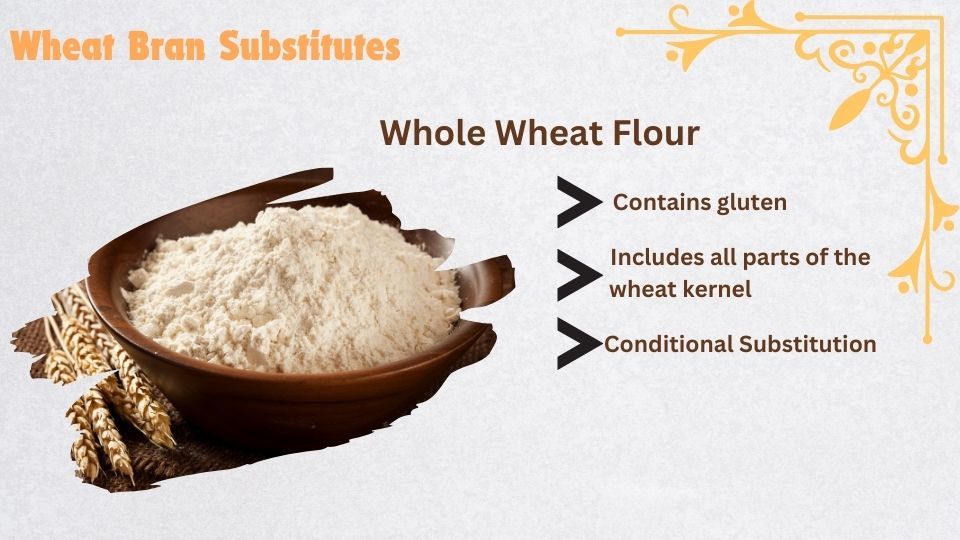
Some recipes demand the use of conventional wheat flour and wheat bran. In such cases, using whole wheat flour can be a decent substitute for wheat bran and conventional flour. After all, whole wheat flour means that it has been made by milling the whole wheat kernel, including the bran, germ, and endosperm.
As an aside and to avoid any possible confusion, the wheat germ is the name of a part of the grain. It has nothing to do with the harmful “germs” we hear so much about in our daily life.
Conventional flour often removes the bran and endosperm. Removing the bran helps with the texture while removing the endosperm helps with the shelf-life of the flour. Whole wheat flour keeps all these parts of the wheat kernel and their nutrition intact. That’s partially a reason for its different texture.
It should be noted that this substitution only works when your recipe demands wheat bran. For recipes that don’t include wheat bran, it’s not always advisable to substitute wheat flour with whole wheat flour.
Additionally, substituting whole wheat flour for wheat bran only works when your recipe demands a significant amount of flour and wheat bran. If the recipe doesn’t require wheat flour or uses wheat bran in only a small quantity, this substitution will not yield desired results.
As you can guess, whole wheat flour contains gluten.
2. Oat Bran
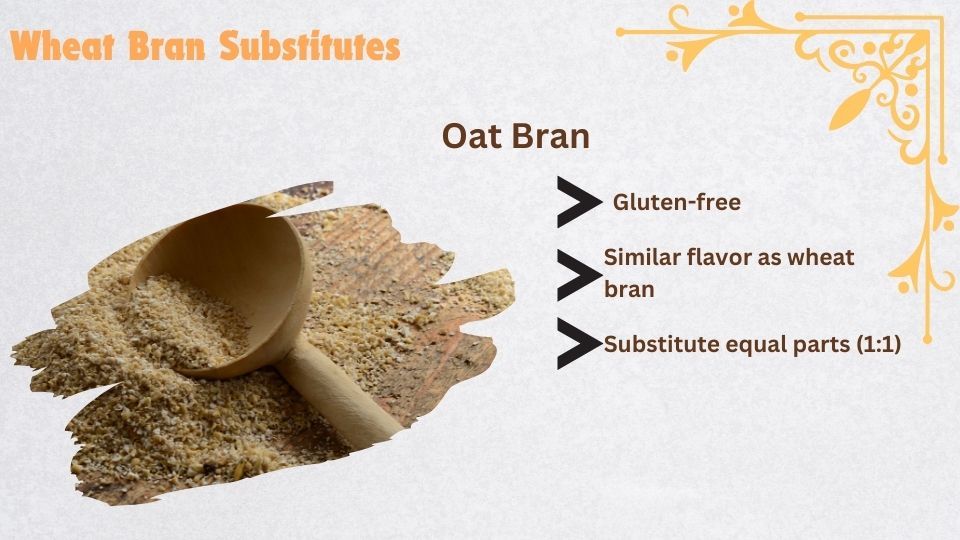
Oat bran is an excellent gluten-free and nutrition-rich substitute for wheat bran. In some ways, oat bran might even be considered healthier. It has nearly twice the fiber content of wheat bran, which can be beneficial to gut health and heart health. Similarly, while it’s rich in other nutrients, wheat bran has a few others where it excels.
One reason oat bran is useful for substitution is because it has a softer texture and a similar nutty flavor (but not the same) as wheat bran. It also works as a suitable binding agent for the recipe, thus taking on several roles.
Conventional wisdom is to do a 1:1 substitution, which is to use an equal amount of oat bran to substitute for wheat bran.
3. Rice Bran
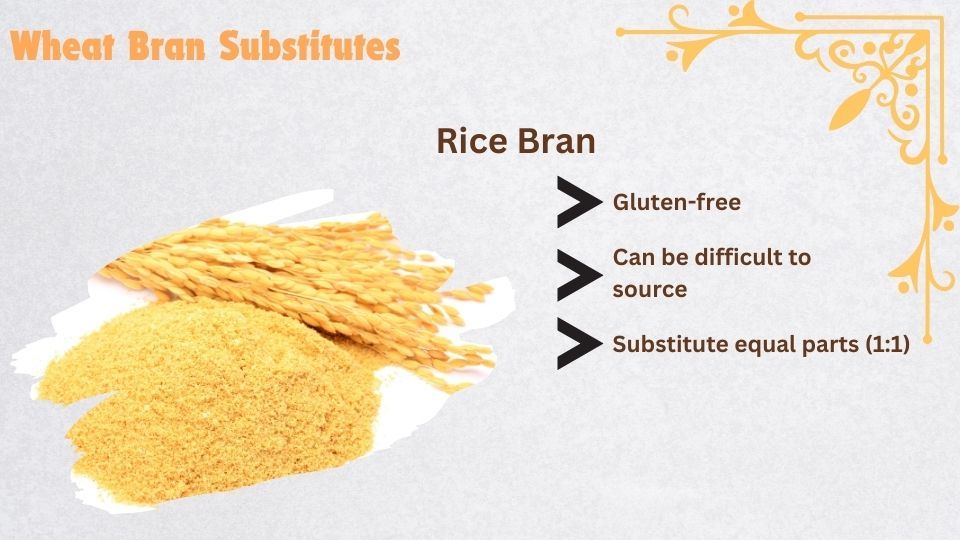
Rice and wheat are both popular grains and staples around the world. Much like wheat, rice too has its bran removed before it is shipped to consumers. And rice bran can do a great job substituting for wheat bran. The taste and texture are quite similar, so the substitution works just fine.
Interestingly, rice bran is also commercially used to make rice bran oil. This oil is popular in several countries in Asia, but mostly in Japan and India. This popularity also makes rice bran more difficult to source, or a rarer ingredient on shop shelves. As compared to rice bran, wheat bran is readily available.
In most cases, substituting in equal amounts (1:1) should work with rice bran and wheat bran.
4. Oatmeal
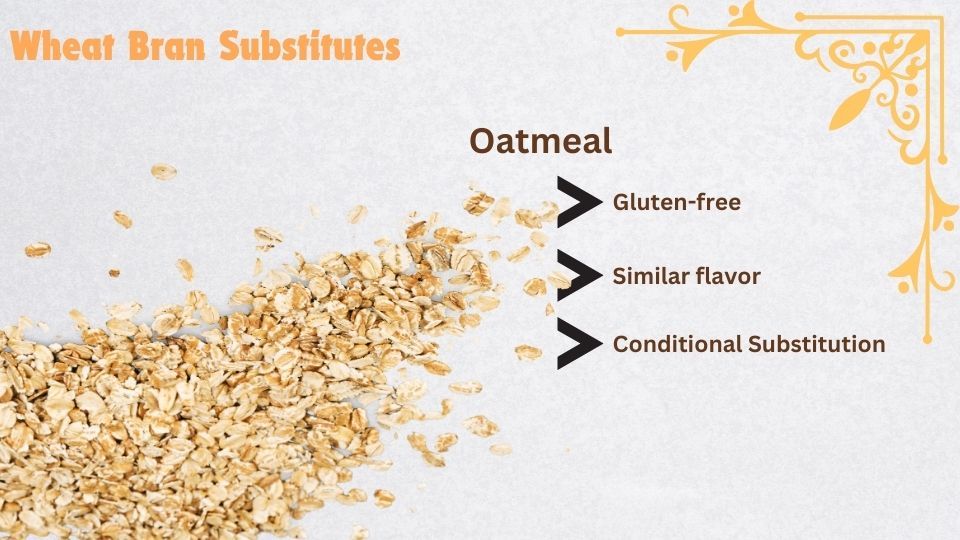
Oatmeal is a decent, gluten-free alternative for wheat bran. This includes the whole oat groat, including the bran. In a sense, oatmeal is similar to the whole wheat flour we discussed, in the sense that the entire groat (grain) is used in its preparation.
So, oatmeal includes the oat bran and the rest of the oat. This combination can make it suitable for substituting wheat bran, where the oat bran does much of the heavy lifting, while the remaining groat provides additional support. This will cause a notable change to the texture of the recipe.
For substituting wheat bran with oatmeal, you’ll want to start with a 1:1 ratio, though it’s possible that the recipe will require more oatmeal to stay balanced.
5. Corn Bran
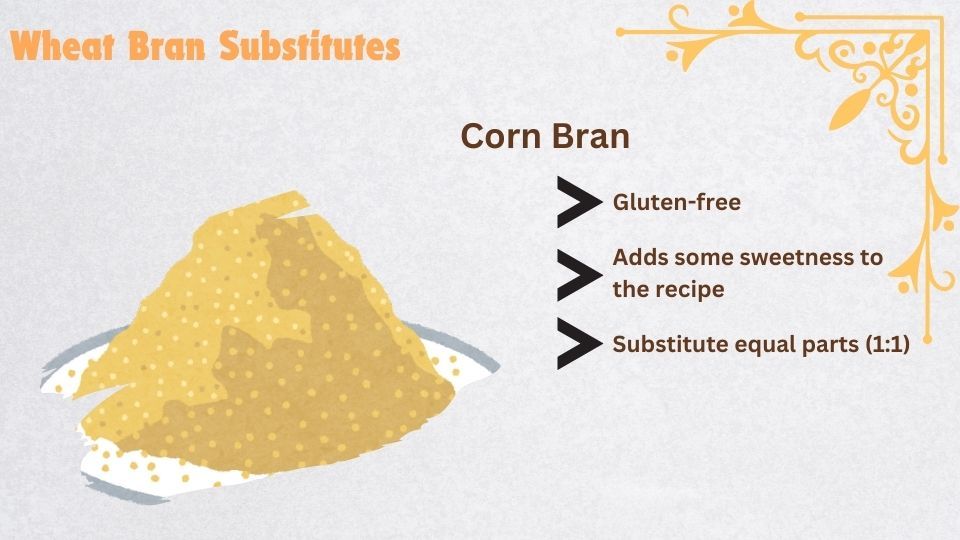
Corn bran can work pretty well as a substitute to wheat bran. It is the product of dry milling corn kernels that have not been steeped. Much like other types of bran, it is rich in fiber and nutrients.
Apart from bringing a slight change in texture, corn bran can also bring about a taste in the flavor. Additionally, it will add a natural touch of sweetness that is usually missing in wheat bran.
When using this as a substitute, a ratio of 1:1 (equal amounts) should work just fine.
6. Flaxseed
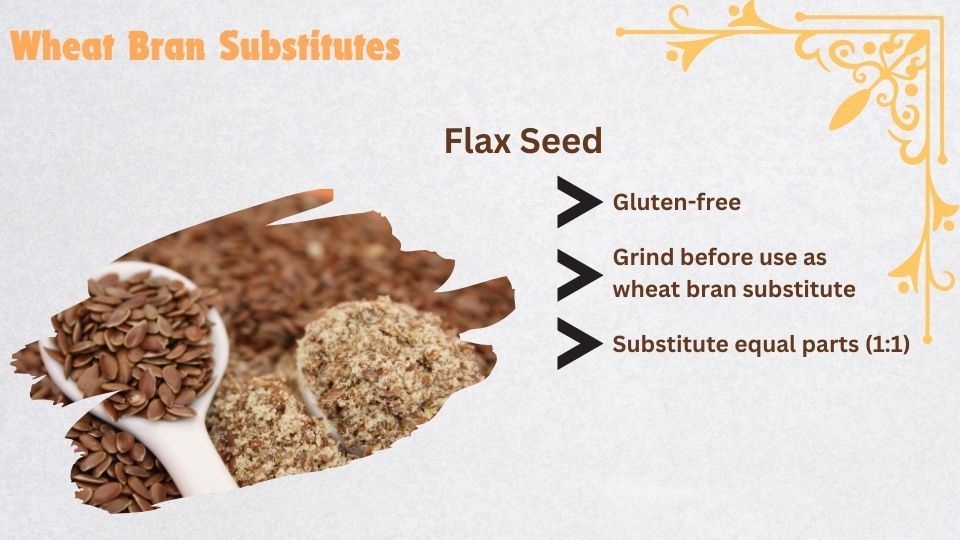
Flaxseeds are gluten-free, rich in fiber, and full of nutrients. They’re also an acceptable substitute for wheat bran in several recipes. The substitution requires milled flaxseed, which might be difficult to source. While flaxseed is readily available in most places, milled flaxseed can be rare.
It has a good nutty flavor, much like wheat bran and can absorb a significant amount of water. It’s also a good binding agent and fulfills many roles that would belong to wheat bran in a recipe. These qualities make it a good substitute.
Besides, if you’re a vegan or vegetarian, the Omega-3 fatty acid in flaxseed should be a welcome addition to your diet. It is packed with other nutritious elements as well, making it a healthy option.
You can start with a 1:1 substitution, but adjustments will be necessary.
7. Farina (Cream of Wheat)
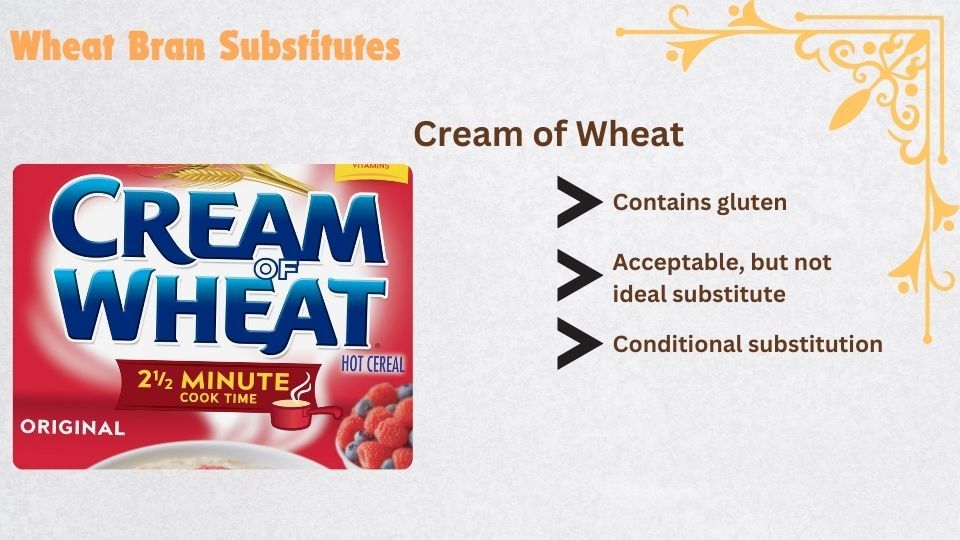
Farina is a form of milled wheat that’s fairly common in the USA. In many parts, it is better known as Cream of Wheat, which is a brand selling farina as a breakfast porridge mix.
It has a relatively rougher texture compared to flour and is made from whole wheat kernels. As such, it retains a significant amount of the bran, along with the nutrition. The relatively coarse texture might also be more useful in using this as a substitute for wheat bran and can result in a more agreeable texture for the recipe.
Recipes And Methods To Know When Using Substitutes For Wheat Bran
Wheat Bran Taste And Texture
Wheat bran has a distinct taste and texture. It is generally more rough and coarse than conventional flour, thus giving a different texture to recipes where it is used. In many cases, the texture may appear coats and somewhat less refined than conventional flour. It also has something of a nutty and sweet flavor, it can taste a bit earthy and chewy.
While all these could be looked upon as positive characteristics, they often don’t line up with the smooth textures and flavors that could “melt in your mouth”. Many people prefer the more subdued taste and texture of conventional flour.
This is one of the reasons why wheat bran is usually removed during the production of conventional flour.
However, lately, there has been more interest in wheat bran and recipes have found creative ways to include it. Through these recipes, many of the lesser desirable features of wheat bran are covered, while its nourishing benefits are added.
Additionally, with people putting more focus on their health, wheat bran and similar products have gained more acceptance, overcoming their presumed lower popularity.
Is Wheat Germ The Same As Wheat Bran?
The germ and the bran are two different parts of the wheat grain, and therefore they’re not the same.
A wheat grain or kernel can be divided into three parts. These are:
- Bran: This is the outermost layer of the wheat kernel and covers it entirely. This part is slightly rough and coarse. The bran is not the same as the husk, which is a protective layer that covers the wheat kernel. On the other hand, the bran is very much a part of the kernel.
- Endosperm: The endosperm is the inner part of the grain. To use an analogy, consider an apple. The bran would be the peel and the endosperm is the apple flesh. Conventional flour is made from the endosperm, which allows it a somewhat neutral taste, while also increasing the shelf life.
- Germ: The wheat germ is the innermost part of the wheat kernel. To use our apple analogy, these would be the seeds inside the apple. The wheat germ would be the part that would grow into the plant, using the endosperm for initial nutrition. In producing conventional flour, the wheat germ is removed from the grain as a way to help increase the shelf life of the product.
As we see, the wheat bran and wheat germ are entirely different parts of the wheat kernel, with very different roles. However, both these parts are removed during the production of flour as a way to maintain the taste, texture, and shelf life of the product.
What To Know When Using Wheat Bran Or Its Substitutes In Baking
If you conventionally use flour for your cooking and are trying a recipe that uses wheat bran or its substitutes, there are a few things to know. First off, there is bound to be a change in texture and flavor.
Wheat bran has something of a nuttier and earthier taste compared to conventional flour. Oat bran, which is a great substitute for wheat bran, has a more pronounced nutty taste. Corn bran, which too is an excellent substitute for wheat bran, has a more neutral taste but adds some sweetness. Flaxseed is somewhat more neutral in its flavor.
There will also be a change in the texture and density of the baked goods. Expect it to be more dense and with a greater body. You might also notice a relatively more coarse texture.
When baking, recipes that use bran will usually require a higher amount of water or liquid to account for the higher absorption. Without the additional liquid, the recipe might feel dry and chewy.
Using bran in baked goods is also considered to be healthier and has been studied scientifically. For example, conventional biscuits or cookies are considered high in sugar and fats, but lack fiber and several other nutritional aspects. A significant part of the problem can be remedied by adding wheat bran to cookie dough or biscuits.
Using Wheat Bran And Substitutes In Smoothies And Cereals
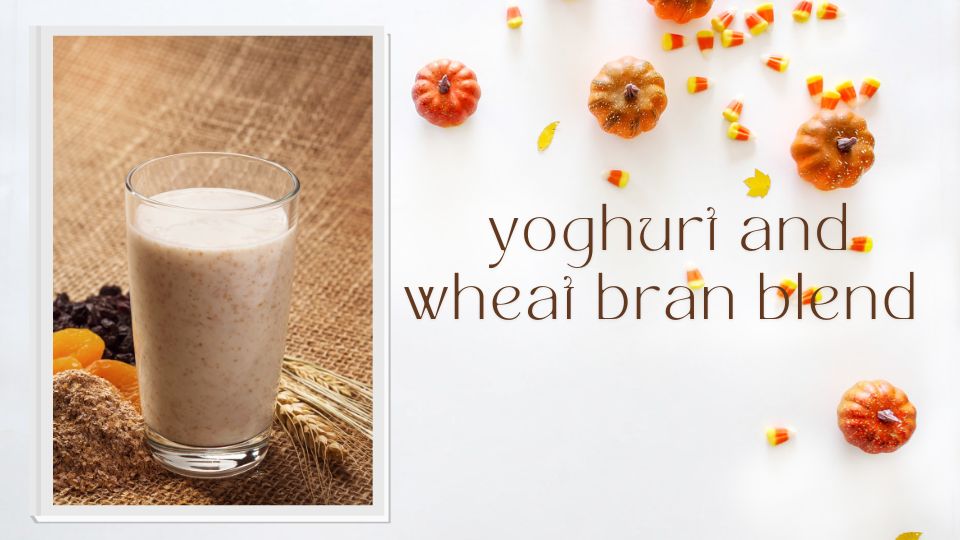
Despite all its benefits, many people simply don’t like the taste or texture of wheat bran. This applies to several of its substitutes as well, including oat bran and corn bran.
However, including them in smoothies or cereals can be an easy way out of this problem.
Smoothies especially work very well with these recipes. Simply make your smoothie as you would, but add a spoon of wheat bran (or the substitute of your choice) to the mix. Once your smoothie is prepared, it will have a little bit of thicker and pleasant texture, but will remain a delicious treat.
Similarly, adding a sprinkling of wheat bran or your choice of substitute to your breakfast cereal can add this nourishing food to your diet without having to go through any trouble.
It might also be worth considering alternative breakfast cereals like Bran Flakes. This breakfast cereal contains a mix of wheat bran and oat bran. However, it should not be seen as the same as wheat bran or oat bran. This is a processed food and includes several other ingredients.
Substituting For Wheat Bran And Understanding Your Options
Getting substitutes for wheat bran can be helpful, and thankfully, several good and nutritious foods can do the job well. The article above details several aspects, inspiration, and specifics when choosing the right substitute.
So, whether you want a gluten-free option, don’t have wheat bran at home, or would just prefer a different texture – the options discussed here have you covered.
It’s important to understand that any substitution will alter the taste, texture, or both of the recipe. Additionally, you might want to balance other aspects as well. So, it’s best to be careful when choosing an alternative.

